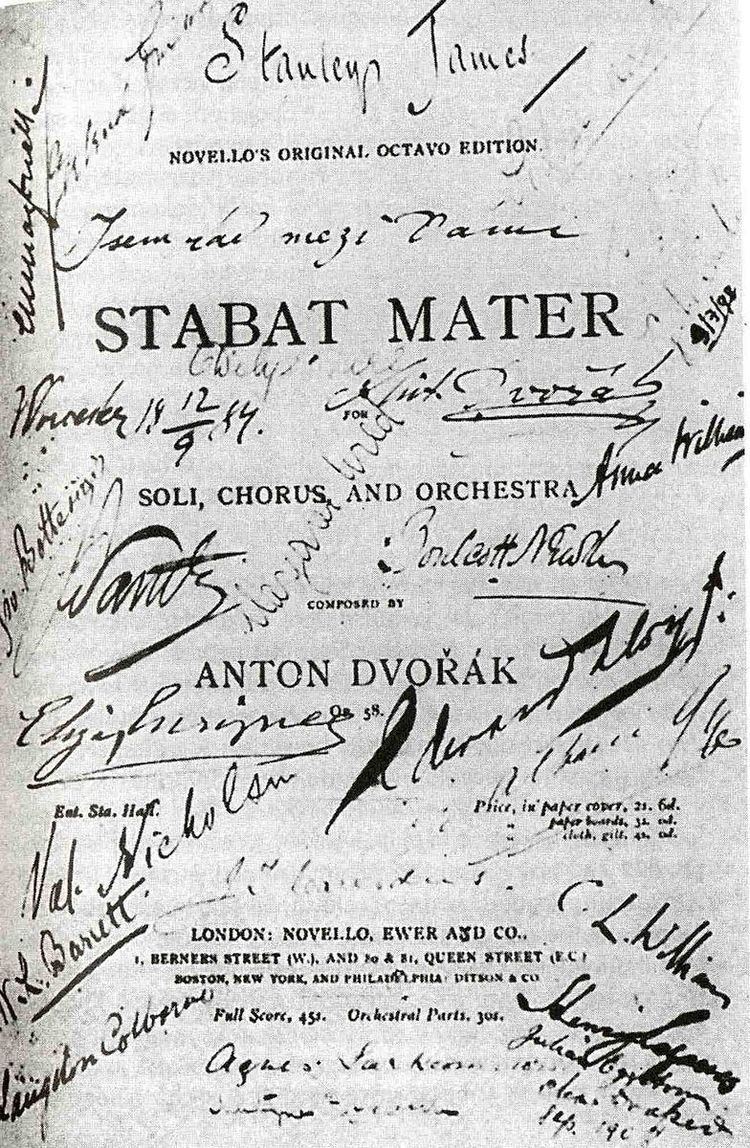 | ||
Stabat Mater (Op. 58, originally Op. 28, B. 71) for soli, choir and orchestra is a religious cantata by the Czech composer Antonín Dvořák based on the text of the Stabat Mater. The work was sketched in 1876 and completed in 1877.
Contents
Background
The composing of the cantata was Dvořák's reaction to the death of his daughter, Josefa. The sketch was written between 19 February and 7 May 1876, and was dedicated to František Hušpauer "as a souvenir to the friend of his young days." However, Dvořák was forced to postpone the orchestration of the work due to his other obligations. He returned to the final stylisation of the composition in 1877, when his two surviving children died within a short time of each other. The definitive version of the score was written between the beginning of October and 13 November 1877 in Prague.
Stabat Mater is Dvořák's first work on a religious theme. It is divided into ten individual parts; only the first and the last part are thematically connected.
The first performance took place on 23 December 1880 at the concert of the Jednota umělců hudebních (Association of Musical Artists) in Prague. The performers included the operatic ensemble of the České prozatímní divadlo (Czech Provisional Theatre), under the conductor Adolf Čech, with the soloists Eleanora Ehrenbergů, Betty Fibich, Antonín Vávra and Karel Čech. The composer Leoš Janáček conducted the work a year and half later, on 2 April 1882, in Brno. Performances abroad (Budapest, London) soon ensued.
The cantata was published in score, with parts and piano vocal score (arranged by Dr. Josef Zubatý) by German publishing house N. Simrock in 1881. On this occasion Dvořák also changed the opus number.
The original version for piano, chorus and vocal quartet, containing only seven movements, has been recorded by Accentus/Equilbey with Brigitte Engerer, piano.
Structure
The composition consists of ten parts:
The first movement is an extended sonata-form in symphonic style. It opens with a long orchestral introduction, then repeated with the chorus. A contrasting second theme is introduced by the soloists. A development section leads to the return of the opening material.
The organ has an independent part accompanying the female semi-chorus in the fourth movement, and is not used otherwise.
Similarly, the cor anglais has a solo line in the opening of the second movement and is otherwise absent. Though not specified in the score, it can easily be played by one of the two oboists, as they are not playing during this section.
The final movement recalls the opening themes of the work, but then turns into the major key for a triumphant Amen fugue of considerable complexity.
The cantata is scored for an orchestra of: 2 flutes, 2 oboes, cor anglais, 2 clarinets in A, 2 bassoons, 4 horns (two in F, two in D), 2 trumpets, 3 trombones, tuba, timpani, organ and strings.
The solos are written for soprano, tenor, alto, bass, accompanied with the SATB choir.
The approximate duration of the work is 90 minutes.
